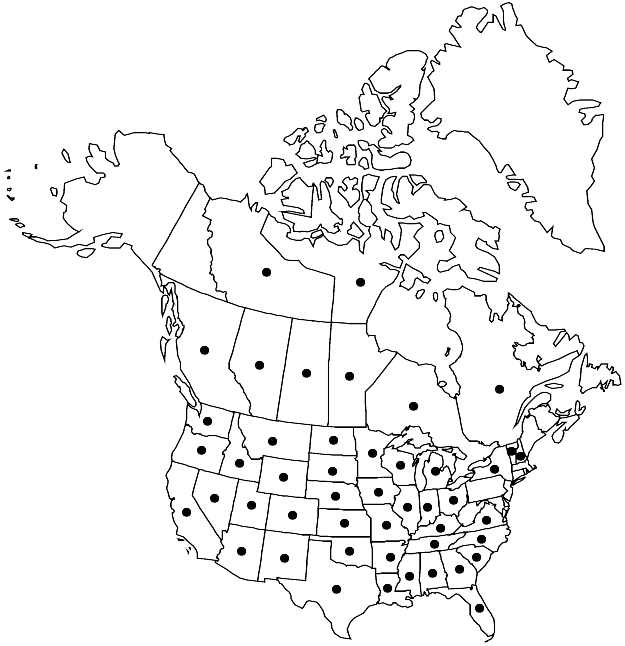Descurainia pinnata
Mem. Torrey Bot. Club 5: 173. 1894.
Annuals; glandular or eglandular; sparsely to densely pubescent, sometimes glabrous distally, canescent or not, trichomes dendritic. Stems erect, unbranched or branched basally and/or distally, (0.8–) 1.3–5.7 (–9.2) dm. Basal leaves: petiole 0.5–3.6 cm; blade 1-pinnate or 2-pinnate, ovate or oblong to oblanceolate in outline, 1–15 cm, lateral lobes (4–9 pairs), linear or oblanceolate to ovate, margins entire or dentate. Cauline leaves sessile or shortly petiolate; blade smaller distally, distal lobes often narrower, surfaces densely pubescent. Racemes considerably elongated in fruit. Fruiting pedicels usually ascending to divaricate or horizontal, rarely descending (at 20–110º angle), straight or slightly recurved, 4–18 (–23) mm. Flowers: sepals spreading to ascending, yellow, purple, or rose, oblong, 0.8–2.6 mm, pubescent; petals (whitish or yellow), narrowly oblanceolate, 1–3 × 0.3–1 mm; median filaments 1–2.8 mm; anthers 0.2–0.4 mm. Fruits erect to ascending, usually clavate, rarely broadly linear (wider distally), not torulose, 4–13 (–17) × 1.2–2.2 mm; valves each with distinct midvein; septum not veined; ovules 16–40 per ovary; style obsolete, 0.02–0.2 mm, glabrous. Seeds biseriate, reddish-brown, oblong, 0.6–0.9 × 0.4–0.5 mm.
Distribution

Alta., B.C., Man., N.W.T., Nunavut, Ont., Que., Sask., Ala., Ariz., Ark., Calif., Colo., Fla., Ga., Idaho, Ill., Ind., Iowa, Kans., Ky., La., Mich., Minn., Miss., Mo., Mont., N.C., N.Dak., N.H., N.Mex., N.Y., Nebr., Nev., Ohio, Okla., Oreg., S.C., S.Dak., Tenn., Tex., Utah, Va., Vt., Wash., Wis., Wyo., n Mexico
Discussion
Subspecies 4 (4 in the flora).
Plants assigned to Descurainia pinnata by various authors represent one of the most complex assemblages of any North American Brassicaceae. L. E. Detling (1939) divided it into eleven subspecies, of which R. C. Rollins (1993) accepted eight. The species includes series of populations that show tremendous variability in every conceivable character, and the variation is continuous between extremes. Some of the taxa recognized by these authors were based solely on trivial variations in the degree of pubescence on the distal parts, shape of the distalmost leaf segments, and presence or absence of glands. The latter character can vary within a given population and, therefore, its utility in distinguishing taxa is questionable at best. Cases in point are Cully s.n. (spring 1984) and Worthington 26353, both at UNM, collected from Bernalillo and Luna counties (New Mexico), respectively; each sheet has both glandular and eglandular forms.
As delimited by L. E. Detling (1939) and R. C. Rollins (1993), subspp. halictorum and menziesii represent a heterogeneous assemblage of intermediates within Descurainia pinnata and between it and other species. In the absence of thorough studies on these subspecies, we prefer to avoid placing them in the synonymy of a putative parental species or recognizing them as subspecies of a parent. Readers interested in the synonymies of subspp. halictorum and menziesii may consult Detling and Rollins.
Molecular studies by B. E. Goodson (2007) indicated that some taxa previously included in Descurainia pinnata (i.e., subspp. filipes, nelsonii, paradisa, and paysonii) should be placed elsewhere. While the molecular data were not able to resolve the remaining subspecies, a critical evaluation of morphology shows that the entire D. pinnata complex falls into at least four relatively distinct groups recognized here as subspecies.
Selected References
None.
Lower Taxa
Key
| 1 | Rachises glabrous, eglandular. | Descurainia pinnata subsp. glabra |
| 1 | Rachises sparsely to densely pubescent, glandular or eglandular | > 2 |
| 2 | Plants canescent, often eglandular; stems branching basally or distal to base; sepals purple or rose. | Descurainia pinnata subsp. ochroleuca |
| 2 | Plants not canescent, often glandular; stems unbranched basally; sepals yellow or rose | > 3 |
| 3 | Fruiting pedicels 4-14(-17) mm, forming (60-)70-90(-110)º angles; sepals rose (at least apically), 0.8-2 mm; petals 1-1.8 mm. | Descurainia pinnata subsp. pinnata |
| 3 | Fruiting pedicels (7-)10-18(-23) mm, forming 20-60(-80)º angles; sepals yellow, 1.5-2.6 mm; petals (1.7-)2-3 mm. | Descurainia pinnata subsp. brachycarpa |
"elongated" is not a number."thick" is not a number."dm" is not declared as a valid unit of measurement for this property."dm" is not declared as a valid unit of measurement for this property.